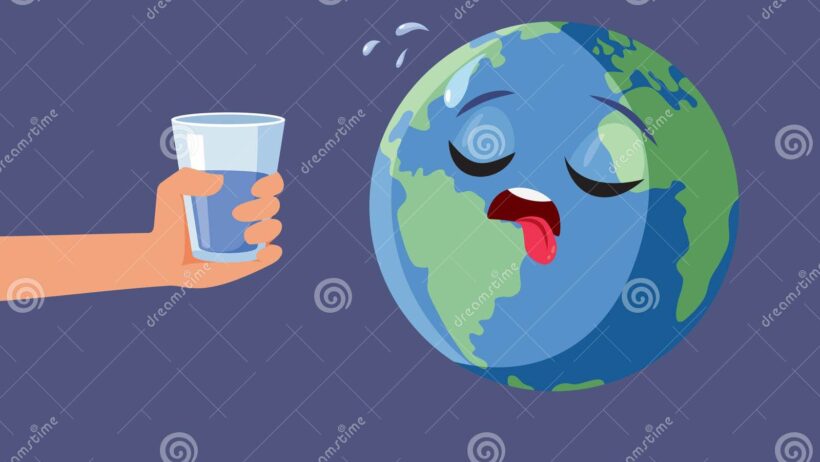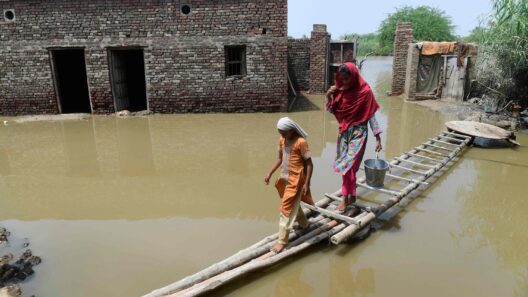As the Earth warms, a poignant metaphor emerges: our planet is akin to a parched individual, desperately seeking respite in a world of dwindling water resources. This “thirsty planet” metaphor encapsulates the alarming reality that global warming exerts profound stress on our precious water systems, creating a cascade of environmental repercussions that ripple across ecosystems and human societies alike. Understanding the ramifications of climate change on our water resources is critical as we confront the multifaceted challenges of a warming world.
Climate change affects the hydrological cycle, a fundamental process that circulates water through our environment. As the planet’s temperature escalates, evaporation rates soar, resulting in increased moisture in the atmosphere. While this may sound like a boon, the chaos it creates is far more destructive. Heavy rainfall events become more frequent, leading to catastrophic floods in some regions, while others succumb to prolonged droughts. The irony of a planet suffocated by water yet starving for it is stark, underscoring the contradictions posed by a warming climate.
One of the most alarming effects of global warming is the melting of glaciers and polar ice caps. Glaciers serve as vital freshwater reservoirs, slowly releasing water that sustains river systems and agricultural practices. As temperatures rise, these glaciers recede at an alarming rate, threatening freshwater supplies for billions. Countries dependent on glacial meltwater for irrigation and drinking face an uncertain future, as these once-reliable sources of water dwindle.
The interplay between temperature and precipitation is further complicated by climate-induced shifts in weather patterns. Regions that thrived in a temperate climate are experiencing altered rainfall distributions, leading to water scarcity in areas once abundant in this vital resource. The Mediterranean region, for instance, is witnessing a profound shift toward drought conditions, with a decrease in precipitation threatening agriculture, biodiversity, and local economies.
Groundwater depletion also exacerbates the issues stemming from global warming. As surface water sources experience stress from changing climatic conditions and pollution, communities turn to groundwater extraction to meet their needs. This practice, however, is unsustainable. Over-extraction of aquifers leads to land subsidence and the degradation of water quality, as saltwater intrudes into freshwater reserves in coastal regions.
Moreover, water quality itself is affected by the rising temperatures associated with climate change. Warmer waters provide a conducive environment for harmful algal blooms, which release toxins detrimental to aquatic life and human health. These phenomena not only impair water quality but also threaten fisheries and tourism-dependent economies. The lakes, rivers, and coastal waters that once provided sustenance and recreation are now facing significant threats, transforming vibrant ecosystems into lifeless entities.
In arid regions, where water scarcity has long been a challenge, the implications of global warming are even starker. The problem is not merely about having enough water; it is about quality, access, and the ability to adapt. Communities are often left without the resources necessary to combat the effects of extreme heat and prolonged droughts. Agriculture, which relies heavily on consistent water availability, faces unprecedented pressures. Farmers are increasingly forced to shift their practices, often with devastating economic consequences.
The Thirsty Planet metaphor draws attention to the intricate connections between climate change and water resources. The repercussions extend beyond environmental and agricultural spheres to touch on socio-political dimensions. Water scarcity can incite conflicts, leading to tensions between nations and communities vying for dwindling supplies. As countries grapple with the implications of climate change, it is imperative to recognize water as a shared resource, fostering collaboration rather than conflict. The management of water resources requires a concerted effort to mitigate the impacts of global warming and work towards sustainable solutions.
Innovation offers a glimmer of hope in this gloomy narrative. Water conservation techniques, such as rainwater harvesting and the employment of efficient irrigation systems, present viable means to alleviate water stress. Investments in water-efficient technologies, such as desalination plants, can help address shortages in coastal areas. Rain gardens and permeable pavements can aid in stormwater management, reducing the risk of flooding while replenishing aquifers. Public awareness campaigns can educate communities about responsible water use, encouraging a cultural shift towards conservation.
Furthermore, climate-smart agriculture represents a crucial avenue for enhancing resilience against the impacts of global warming. Techniques such as crop rotation, agroforestry, and organic farming not only improve soil health but also enhance a farm’s ability to retain moisture. By working in harmony with nature, these practices can mitigate the impacts of climate change while securing food sources for an ever-growing population.
The challenges posed by global warming are profound, and the imagery of a thirsty planet encapsulates the urgency with which we must act. Our water resources are not just a commodity; they are the lifeblood of ecosystems and human societies alike. A sustainable approach to water management that considers the impacts of climate change is essential. Recognizing the interconnectedness of water, climate, and human well-being is paramount in crafting solutions for a healthier planet. As we navigate the complexities of a warming world, our collective responsibility is clear: to protect our precious water resources and ensure a sustainable future for all.






